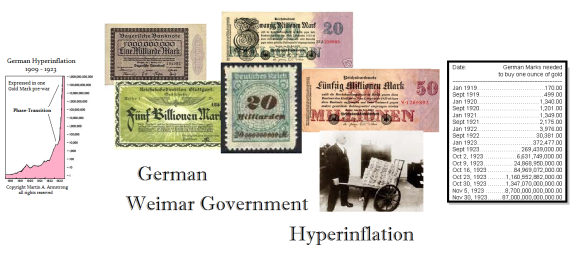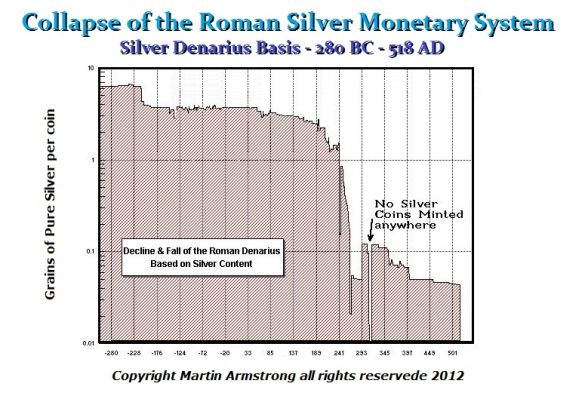Gold & Precious Metals
This One Chart Shows Exactly How Undervalued Gold is Right Now…
Posted by The Sovereign Man
on Monday, 6 October 2014 19:39
October 6, 2014
London, England
For the benefit of anyone living under a rock these past weeks, Bill Gross, the so-called “Bond King” and manager of the world’s largest bond fund (PIMCO), jumped ship before he could be shoved overboard.
PIMCO’s owners, Allianz, must surely regret having allowed so much power to be centralized in the form of one single ‘star’ manager.
In a messy transfer in which nobody came out of well, Janus Capital announced that Bill Gross would be joining to run a start- up bond fund, before he had even announced his resignation from PIMCO (but then again Janus was a two-faced god).
This was deliriously tacky behavior from within a normally staid backwater of the financial markets.
Some financial media reported this as a ‘David vs Goliath’ story; in reality it is anything but.
The story can be more accurately summarized as ‘Bond fund manager leaves gigantic asset gatherer for other gigantic asset gatherer’ (Janus Capital’s $178 billion in client capital being hardly small potatoes).
This writer recalls the giddy marketing of a particularly new economy-oriented growth vehicle called the ‘Janus Twenty’ fund in the UK back in 2000.
Between March 2000 and September 2001, that particular growth vehicle lost 63% of its value. Faddish opportunism is clearly still alive and well.
We discussed this last week, highlighting this seeming anomaly that even as there has never been so much debt in the history of the world, it has also never been so expensive.
This puts the integrity of markets clearly at risk. And we have long sought alternatives that offer much lower credit and counterparty risk.
The time-honored alternative has been gold.
In fact, as the chart below shows, gold has tracked the expansion in US debt pretty handily (editor’s note: the correlation between the two is a strong +0.86).
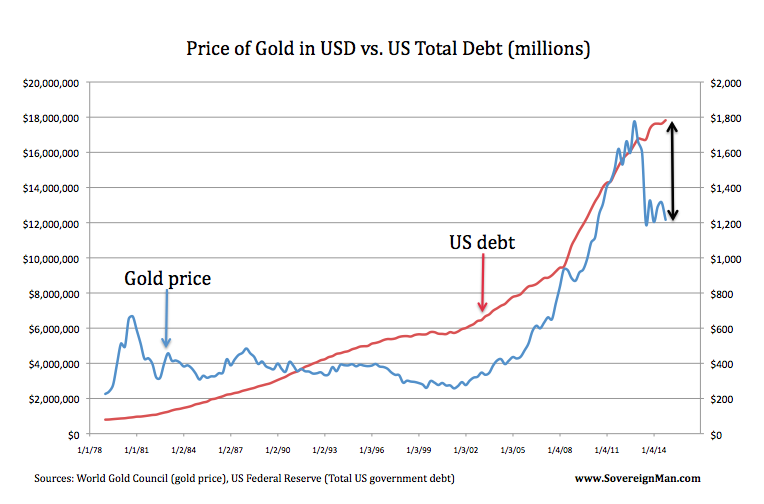
You can see in 2011, the rise in the gold price became overextended relative to the rise in US debt. Then it decoupled and went in the opposite direction.
This is a similar trend to what occurred in the early 1980s. And if one expects that relationship to resume (we do), then gold looks anomalously cheap relative to the rising level of US debt.
A second rationale for holding gold takes into account the balance sheet expansion of central banks:

If one accepts that gold is not merely an industrial commodity but an alternative form of money, then it clearly makes sense to favor a money whose supply is growing at 1.5% per annum over monies whose supply is growing up to 20% per annum.
A third rationale for owning gold is best summed in perhaps the most damning statement to capture our modern financial tragedy.
“We all know what to do, we just don’t know how to get re-elected after we’ve done it.”
This is from Jean-Claude Juncker, former Prime Minister of Luxembourg and current President-Elect of the European Commission.
It’s clear there is a vacuum where bold political action should reside. Elected leaders continue to kick the can down the road and ignore dangers to the system.
And in this vacuum, central bankers have stepped in to fill the void via bond yields that are below the rate of inflation.
They say that to a man with a hammer, everything looks like a nail.
To a central banker facing the prospect of outright deflation, the answer to everything is the printing of ex nihilo money and the manipulation of financial asset prices.
This makes it incredibly difficult to shake off the suspicion that navigating the bond markets over the coming months will require almost supernatural powers in second-guessing both central banks and one’s peers.
For what it’s worth this is a game we won’t even bother playing.
Our pursuit of the rational alternative – proper forms of money and compelling deep value in equity markets – continues. More to follow on this.
[Editor’s Note: Tim Price, Director of Investment at PFP Wealth Management in the UK and frequent Sovereign Man contributor, is filling in for Simon today.]

Is a Long-term Gold Bear Market Possible?
Posted by Martin Armstrong - Armstrong Economics
on Monday, 6 October 2014 15:01
Answer: Taking the metals down short-term is simply a function of further liquidation and a rising dollar. Long-term, I do not see where a return of a bear market is possible. The gold promoters talk about debt and hyperinflation. But that fails to look at real history rather than the few examples of revolutionary governments. The common bond between the hyperinflation of Germany, Hungary, Zimbabwe, France, and colonial America (Continental Dollars) is not paper money – it is the collapse in confidence in government. That unfolds in placed in Germany and Zimbabwe when there IS NO DEBT because people will not buy their bonds. When there is a debt and the government is an established one with power, they first turn against the people and hunt taxes, twist the
rule of law so they win, and that creates deflation. The final nail comes like it did in the city of Mainz – no bid for the debt.
The assumption by the gold promoters has been they will just print more money to cover the debt. But honestly, that requires confidence to keep the game afoot. This is the common element. We will see the decline and fall in an OMG event and not progressive hyperinflation. France has already lost confidence of the people. Hollande has perhaps the lowest support number in all of history. But to save France, there will need to be another revolution for he is determined to stay where he is for the full term. France will crack and the EU may move to inflation BECAUSE they failed to establish a national debt market – one currency requires one debt and one government. As confidence in the EU is collapsing, now they are talking about issuing a national debt. But it is too late. They are exactly in the position of Germany and Zimbabwe compared to the USA which has a debt that is now supporting the world economy as reserves. There are important economic differences at stake here. This is not an issue of OPINION. There are serious structural differences that we will see as this unfolds.
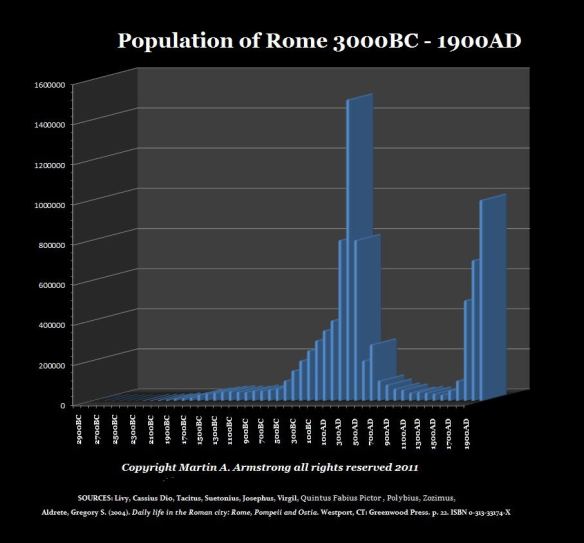
So I do not see gold entering a long-term bear market. We have downside to contend with, but this is how markets simply function. Rome kept raising taxes and twisting the law so people just walked away from their property. They could not pay the taxes and the population moved to the suburbs started farms and relied upon themselves returning to a Villa economy of self-sufficiency.This then was transformed into serfdom for protection from barbarian invasions. Taxes kill the economy and cause people to move just as I reported they are moving from North to South inside the USA.
….more from Martin Armstrong:
Benchmark Cycles
Palladium – To Be or Not to Be
Wave Compression with Technology

Alan Greenspan: Gold Is “Universally Acceptable” & Why China Is Buying
Posted by GoldCore
on Monday, 6 October 2014 12:41
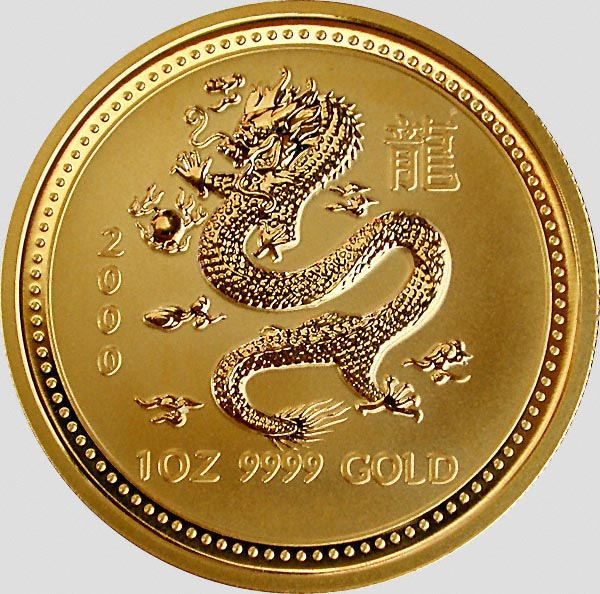 Alan Greenspan, former Chairman of the Fed, had an article entitled “Golden Rule – Why Beijing Is Buying” published in Foreign Policy, the journal of the influential Council on Foreign Relations in which he extols the virtues of gold as “universally acceptable.”
Alan Greenspan, former Chairman of the Fed, had an article entitled “Golden Rule – Why Beijing Is Buying” published in Foreign Policy, the journal of the influential Council on Foreign Relations in which he extols the virtues of gold as “universally acceptable.”
Greenspan, former Chairman of the Federal Reserve![]() Board of the United States from 1987 to 2006, and a key architect in the global financial crisis, points out that if the world’s largest gold consumer, China, used a portion of its massive $4 trillion foreign exchange reserves to buy enough gold bullion it could displace the U.S. as the world’s largest holder of gold bullion. The U.S. holdings are believed to be just over 8,500 tonnes with an estimated value of just $328 billion as of spring 2014.
Board of the United States from 1987 to 2006, and a key architect in the global financial crisis, points out that if the world’s largest gold consumer, China, used a portion of its massive $4 trillion foreign exchange reserves to buy enough gold bullion it could displace the U.S. as the world’s largest holder of gold bullion. The U.S. holdings are believed to be just over 8,500 tonnes with an estimated value of just $328 billion as of spring 2014.
….related: Currency Wars ! Russia, Kazakhstan Buy Very Large 30 Tons Of Gold In August

Precious Metals to Face More Body Blows
Posted by Jordan Roy-Byrne
on Friday, 3 October 2014 19:45
Gold has broken below $1200 this morning in what should begin the final breakdown. In weekly and monthly terms $1200 was the remaining support. Sure Gold could bounce from $1180 but todays breakdown is more significant. Both metals are now in breakdown mode while the mining stocks continue to slide. There is more downside ahead and bulls should continue to stand aside before a favorable buying opportunity emerges.
The monthly chart of Gold and Silver is below. We know that Silver has already broken down. It peaked before Gold and could bottom first. Silver is trading at $16.88 as I pen this. The next major monthly support is $15. With Gold trading at $1192, its next monthly support is below $1100. The 50% retracement is at $1080 and more support lies at $1040.

Those downside targets fit well with the bear analog charts. In this Gold specific chart we removed the two extreme bears. We can see how the current bear compares to three other bears.

The bear analog chart for Silver suggests its current bear market will end first and is very close to ending. In price terms this is now the second worst bear market ever for Silver. In terms of time it is close to being the third worst bear ever.

Turning to the miners, the HUI Gold Bugs Index is trading at 190 as we pen this. The weekly line chart shows 168 as very strong multi-year support. That is about 12% downside from current prices.

GDXJ (not shown) has been the strongest of the mining indices. It was the last to break its May low. It has 9% downside to its December low. GDXJ was down 82% at that low. Any breakdown to a new low is very likely to be a false breakdown given the current age and severity of the bear market.
We were bullish most of 2014 but quickly changed our tune as the evidence shifted. In our most recenteditorial we noted the downside risk but the eventual shift from risk to an amazing opportunity. These charts are a few of the tools we can use to potentially identify the start of that amazing opportunity. For now, Gold and Silver continue to have more downside until very strong support targets. The same goes for the mining stocks. I see a potential lifetime buying opportunity in the weeks and months ahead. We invite you to learn more about our premium service including a report on our top 5 buys at the coming bottom.
Good Luck!
Jordan Roy-Byrne, CMT

In 1324, Mansa Musa, the tenth emperor of the Mali Empire, set off from Western Africa on his pilgrimage to Mecca.
This was no Spartan journey. He was accompanied on his way by a procession of 60,000 men and 12,000 slaves, each of whom carried up to four pounds in gold bars.
Musa is might just have been the richest person of all time, with an accumulated wealth estimated at $400 billion valued in today’s increasingly worthless dollars.
But it wasn’t just kings and emperors who held gold. Gold has been the most widely-used medium of exchange in world history… across all points of the globe.
Ibn Battuta was a 14th century traveler and explorer whose famous grand adventure spanned 75,000 miles over the course of 24 years, much like Marco Polo’s.
Everywhere he traveled– North Africa, Middle East, Central Asia, India, Southeast Asia, China – gold was either the dominant currency or an easily accepted medium of exchange.
This barbarous relic has stood the test of time across cultures around the world for millennia as a form of wealth.
Most people in the West have completely lost sight of this.
They view the value of gold through the lens of paper currency, i.e. an ounce of gold is ‘worth’ 1,215 US dollars.
This is a deeply flawed perspective.
Looking at the gold price moving up and down in US dollars is something like sitting in a rowboat on choppy waters believing that it’s the beach that’s moving up and down.
Einstein might say that it’s all relative, but only one has any real stability.
But perspectives can and do change.
There once was a time when most people believed that the entire universe revolved around the Earth.
This was flawed (and arrogant) view, and it was eventually corrected.
Thinking that the global economy revolves around the US dollar is just as flawed and arrogant. And it will soon be discredited just the same.
History tells us that dominant monetary systems invariably have an expiration date.
From the Byzantine solidus to the British pound, this is especially true when a superpower enters into decline and plays destructive games with its currency.
Today’s system where an unelected central banking elite conjures trillions of dollars and euros out of thin air is no different. It has an expiration date too.
Change is never easy. People don’t like it, and will resist change even if their current situations are terrible. Inertia is the most powerful force in the universe after all.
Desirable or not, it’s happening. The US dollar’s days are numbered.
Now, gold, with its millennia-long history is making a comeback. We’re not just talking about it as a store of wealth or a speculation, but as a regular form of currency.
Moving us back in this direction, Singapore Exchange launched a new arrangement this week where institutional-sized gold contracts will settled not in cash, but in 1kg bars of gold.
This means that each of these contracts is intended to deliver and store gold in Singapore on behalf of large financial institutions, central banks, and even governments.
Sure, Singapore wants to advance itself as THE gold hub of Asia. We’ve been writing to our premium members about this for years
But more importantly, it’s quite telling that major insiders within the financial system itself are pursuing this contract.
They’re effectively setting up a new system, in Asia, to afford governments and central bankers the opportunity to trade in their US dollars for something real.
Just like yesterday’s post about the renminbi / euro convertibility, this is truly a canary in the coalmine moment for the future of the US dollar… as well as gold’s emerging role in the financial system of tomorrow.


-
I know Mike is a very solid investor and respect his opinions very much. So if he says pay attention to this or that - I will.
~ Dale G.
-
I've started managing my own investments so view Michael's site as a one-stop shop from which to get information and perspectives.
~ Dave E.
-
Michael offers easy reading, honest, common sense information that anyone can use in a practical manner.
~ der_al.
-
A sane voice in a scrambled investment world.
~ Ed R.
Inside Edge Pro Contributors

Greg Weldon

Josef Schachter

Tyler Bollhorn

Ryan Irvine

Paul Beattie

Martin Straith

Patrick Ceresna

Mark Leibovit

James Thorne

Victor Adair

